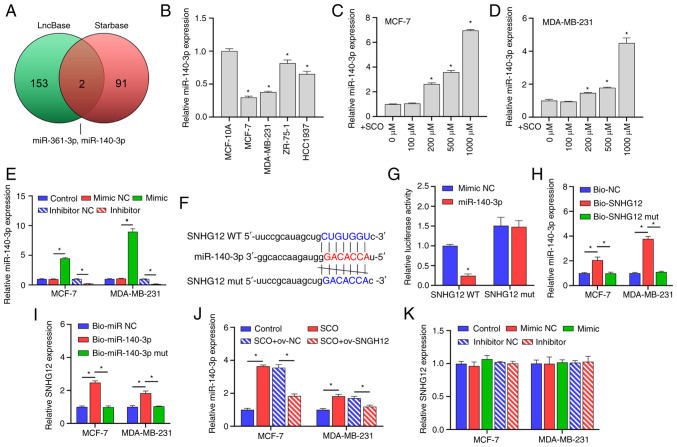Figure 3.
SNHG12 acts as a ceRNA to adsorb miR-140-3p. (A) LncBase and Starbase joint analysis of potential targets for SNHG12. (B) RT-qPCR analysis of the differential expression of miR-140-3p in MCF-7, MDA-MB-231, ZR-75-1 and HCC1937 cells compared to MCF-10A. *P<0.05 vs. MCF-10A. RT-qPCR analysis of the difference in expression of miR-140-3p in (C) MCF-7 and (D) MDA-MB-231 cells under different SCO doses. *P<0.05 vs. 0 µM. (E) RT-qPCR analysis verifying the effectiveness of the miR-140-3p mimic/inhibitor. *P<0.05. (F) Bioinformatic analysis of the potential binding sites between SNHG12 and miR-140-3p. (G) Dual luciferase analysis of the binding between SNHG12 and miR-140-3p. *P<0.05 vs. mimic NC. RNA pull-down analysis was used to examine the binding between (H) bio-SNHG12 and miR-140-3p, as well as (I) bio-miR-140-3p and SNHG12, respectively, in MCF-7 and MDA-MB-231 cells. (J) RT-qPCR analysis of miR-140-3p expression under the combined action of SCO and ov-SNHG12. (K) RT-qPCR analysis of the effect of miR-140-3p mimic/inhibitor on SNHG12 expression. *P<0.05. SCO, scoparone; lncRNA, long non-coding RNA; SNHG12, small nucleolar RNA host gene 12; RT-qPCR, reverse transcription-quantitative PCR; NC, negative control; miR, microRNA; Bio, biotinylated; ceRNA, competing endogenous RNA.

